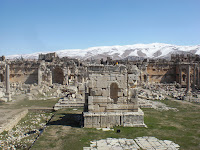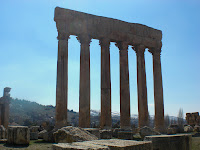 Baalbek, a small city with a population of around 80,000, lies in the northeast of Lebanon, roughly halfway between Beirut and Damascus on a plateau of just under 1000 metres in altitude. It is home to an archaeological site of jawdropping scale - a Roman temple complex originally known as Heliopolis, later converted to Christianity by the Romans themselves and finally passing into Arab and Ottoman hands and researched by German archaeologists during the 19th century.
Baalbek, a small city with a population of around 80,000, lies in the northeast of Lebanon, roughly halfway between Beirut and Damascus on a plateau of just under 1000 metres in altitude. It is home to an archaeological site of jawdropping scale - a Roman temple complex originally known as Heliopolis, later converted to Christianity by the Romans themselves and finally passing into Arab and Ottoman hands and researched by German archaeologists during the 19th century. A sunny and warm Sunday in late February provided a good opportunity to see this ancient wonder. I took an early bus which headed up into the mountains where small patches of snow still littered the hills and a fine panorama of Beirut came into view just before the pass. Entering the city along the highroad provided two 'wow' moments - the 20 metre tall Roman columns coming into view behind the roadside bulidings, and a colourful and lavishly decorated mosque (not part of the archaeological site).
A sunny and warm Sunday in late February provided a good opportunity to see this ancient wonder. I took an early bus which headed up into the mountains where small patches of snow still littered the hills and a fine panorama of Beirut came into view just before the pass. Entering the city along the highroad provided two 'wow' moments - the 20 metre tall Roman columns coming into view behind the roadside bulidings, and a colourful and lavishly decorated mosque (not part of the archaeological site). The group I joined for the day trip was shown around by a gentle man of around 70 who frequently referred to the 'crazy Romans'. He had excellent knowledge and impressed upon us the sheer scale of the site - for example, the 18x3x4 metre foundation stones at one end of the complex are the largest of their type ever built.
The group I joined for the day trip was shown around by a gentle man of around 70 who frequently referred to the 'crazy Romans'. He had excellent knowledge and impressed upon us the sheer scale of the site - for example, the 18x3x4 metre foundation stones at one end of the complex are the largest of their type ever built. After seeing the ruins there was time to take a look around the city. The ubiquitous Lebanese ahlan or 'welcome' was heard often.We bought a falafel for 1000 Lebanese pounds (around 30p) and looked around the market. Here, I realised that I had left my backpack (which contained my passport) in the falafel shop. I hurried back there to find the shop owner and his assistant watching over my bag, grinning cheerfully as they returned it.
After seeing the ruins there was time to take a look around the city. The ubiquitous Lebanese ahlan or 'welcome' was heard often.We bought a falafel for 1000 Lebanese pounds (around 30p) and looked around the market. Here, I realised that I had left my backpack (which contained my passport) in the falafel shop. I hurried back there to find the shop owner and his assistant watching over my bag, grinning cheerfully as they returned it.Following this we visited the remarkable looking Blue Mosque. The Blue Mosque is a Shi'a mosque, as Baalbek is situated within a part of religiously heterogeneous Lebanon which is predominantly Shi'a Islam in denomination. This gives it a noticeably different feel to the (very) roughly half-Sunni, half-Christian Beirut. For those who are not familiar with the distribution of the two main branches of Islam (which for contextualisation can be very loosely compared to Catholic and Protestant Christianity in terms of how far apart they are ideologically), Sunnism is the one most prevalent in the Arabian peninsula, North Africa and Turkey as well as in Pakistan and India; while Shi'ism dominates Iran. The populations of Lebanon, Syria and Iraq are divided to varying extents between the two.
Going back to Baalbek, its Shi'a population has one particular significance in the Lebanese context - support for Hezbollah, the controversial, staunchly anti-Israel resistance organisation. I don't know nearly enough to be able to give a balanced description of Hezbollah's complex military and political history and present, but it has both supporters and opponents within Lebanon and, as its religion is Shi'ism, it is widely supported in Baalbek. This becomes obvious on the highway into the city where the characteristic yellow and green flag of Hezbollah flies from lamp posts beside posters of leader Hassan Nasrallah. Outside the relatively heavily-touristed ruins, touts hawk Hezbollah t-shirts and Palestinian neckerchiefs, in similar spirit to the Che Guevara t-shirts sold in Cuba (and everywhere else in the world), but somewhat more controversial to be seen wearing - it would be a naive or brave tourist indeed who would walk around Beirut displaying the Hezbollah logo.


There is far more to Shi'ism in Baalbek though than support for Hezbollah. We were allowed to visit the mosque and look inside which was a fascinating experience. We walked among people praying and were able to observe the glittering and beautiful interior and a number of interesting differences from Sunni mosques, such as use of a prayer stone, said to come from the Battle of Karbala, and pictures of the prophet Mohammad, banned in Sunni Islam.

No comments:
Post a Comment